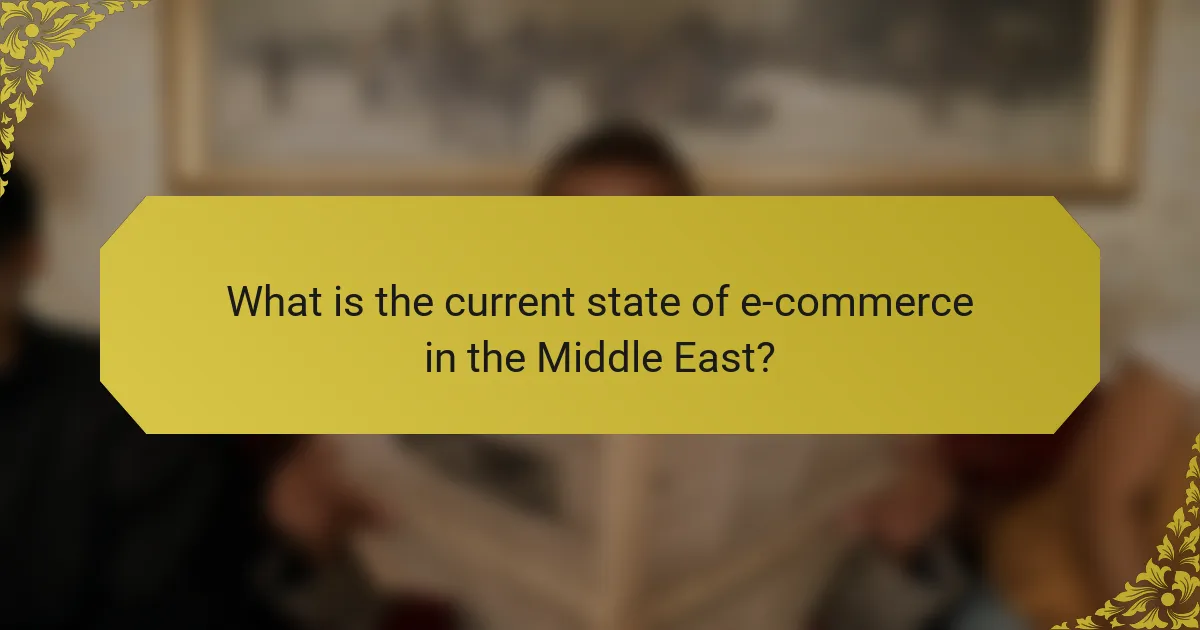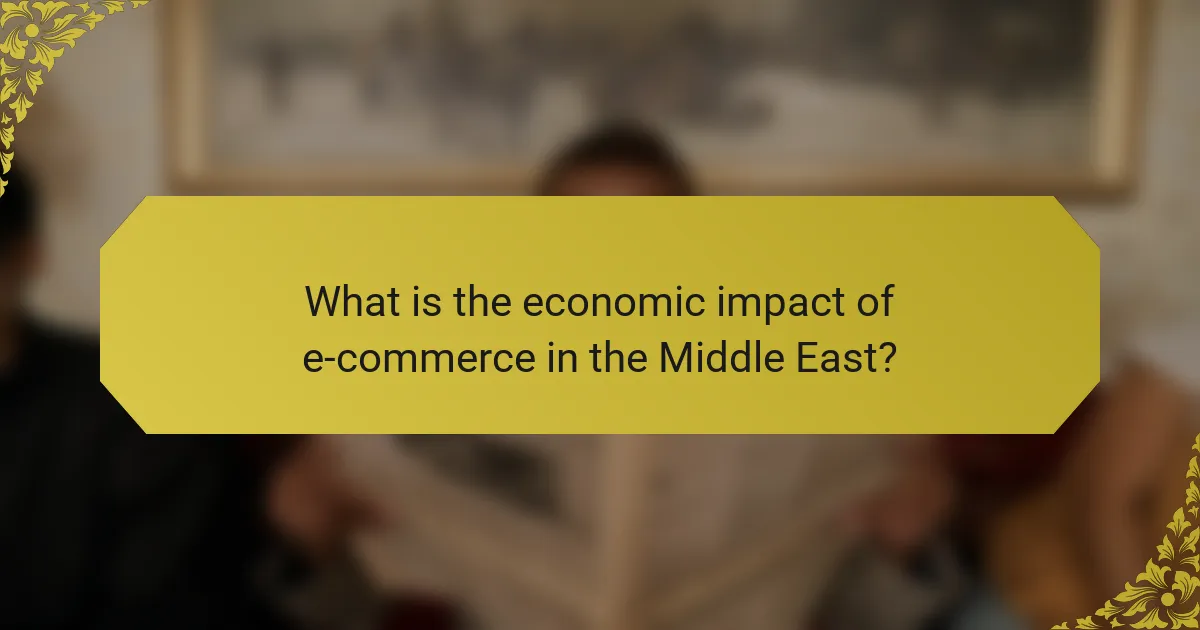
What is the current state of e-commerce in the Middle East?
E-commerce in the Middle East is rapidly growing and evolving. The market is expected to reach $28.5 billion by 2022. This growth is driven by increased internet [censured] and smartphone usage. The COVID-19 pandemic further accelerated online shopping trends. Consumers are increasingly favoring digital platforms for convenience and variety. Major players in the market include Souq.com and Noon.com. Payment methods are diversifying, with a rise in digital wallets. Logistics and delivery services are also improving to meet demand. Overall, the e-commerce landscape is becoming more competitive and innovative in the region.
How has e-commerce evolved in the Middle East over recent years?
E-commerce in the Middle East has significantly evolved in recent years. The market has seen rapid growth, driven by increased internet [censured] and smartphone usage. In 2021, the e-commerce market in the region was valued at approximately $13 billion. This figure is projected to reach $28 billion by 2025, according to a report by Bain & Company.
Consumer behavior has shifted towards online shopping, especially post-COVID-19. Many consumers now prefer the convenience of e-commerce for everyday purchases. Social media platforms have also become vital for e-commerce, with businesses leveraging them for marketing and sales.
Furthermore, local and international players are investing heavily in logistics and payment solutions. This investment enhances the overall shopping experience for consumers. The rise of digital payment methods has facilitated smoother transactions and increased consumer trust in online shopping.
In summary, e-commerce in the Middle East has grown rapidly, influenced by technological advancements and changing consumer preferences.
What key factors have driven the growth of e-commerce in this region?
Increased internet [censured] and smartphone usage have driven the growth of e-commerce in the Middle East. As of 2023, internet [censured] in the region reached approximately 99%. This widespread connectivity enables more consumers to access online shopping platforms. The rise of mobile commerce is also significant, with over 60% of e-commerce transactions occurring via smartphones. Additionally, changing consumer behaviors, particularly among younger demographics, favor online shopping over traditional retail. The COVID-19 pandemic accelerated this trend, pushing many businesses to establish online presence. Government initiatives supporting digital transformation further bolster e-commerce growth. Investments in logistics and payment infrastructure enhance the overall shopping experience. Together, these factors create a robust environment for e-commerce expansion in the Middle East.
What are the major players in the Middle Eastern e-commerce market?
The major players in the Middle Eastern e-commerce market include Souq.com, noon.com, and Namshi. Souq.com, acquired by Amazon in 2017, is a leading online marketplace in the region. Noon.com, launched in 2017, is a significant competitor backed by Saudi Arabia’s Public Investment Fund. Namshi specializes in fashion and lifestyle products, catering to the younger demographic. Other notable players are Carrefour and Jarir Bookstore, both of which have expanded their online presence. The e-commerce market in the Middle East is rapidly growing, with a projected value of $28.5 billion by 2022. This growth is driven by increasing internet [censured] and smartphone usage.
What market trends are shaping e-commerce in the Middle East?
Rapid growth in mobile commerce is shaping e-commerce in the Middle East. The region has seen a 30% increase in mobile shopping in the past year. Increased internet [censured] fuels this trend, with over 90% of the population online. Social media platforms are becoming vital for e-commerce, driving 40% of online sales. Consumers prefer localized content, leading to a rise in Arabic-language websites. Payment solutions are evolving, with a growing acceptance of digital wallets and cashless transactions. Sustainability is gaining traction, influencing consumer choices towards eco-friendly products. Lastly, logistics and delivery innovations are enhancing customer experience, with same-day delivery becoming a standard expectation.
How are consumer preferences influencing e-commerce trends?
Consumer preferences are significantly shaping e-commerce trends in the Middle East. Increased demand for convenience drives consumers to prefer online shopping over traditional retail. A study by Statista indicates that 70% of Middle Eastern consumers favor online purchases due to ease of access. Personalization is another key factor; 60% of consumers expect tailored shopping experiences. Additionally, mobile shopping is on the rise, with 50% of e-commerce transactions occurring via smartphones. Social media influences purchasing decisions, with 40% of consumers discovering products through these platforms. Sustainability is also becoming important, as 30% of consumers prefer brands that demonstrate eco-friendly practices. These preferences are pushing e-commerce businesses to adapt their strategies, enhancing user experiences and expanding product offerings.
What technological advancements are impacting the e-commerce landscape?
Artificial intelligence, mobile technology, and blockchain are significantly impacting the e-commerce landscape. Artificial intelligence enhances customer experiences through personalized recommendations and chatbots. Mobile technology facilitates shopping via smartphones, increasing accessibility and convenience. Blockchain improves security and transparency in transactions, fostering trust among consumers. Additionally, augmented reality allows customers to visualize products before purchasing. The integration of these technologies is reshaping how consumers engage with e-commerce platforms. According to Statista, global e-commerce sales are projected to reach $6.54 trillion by 2022, highlighting the importance of these advancements.

How does consumer behavior affect e-commerce growth in the Middle East?
Consumer behavior significantly influences e-commerce growth in the Middle East. The region has seen a surge in online shopping due to changing consumer preferences. Increased internet [censured] and smartphone usage drive this trend. Consumers now prefer the convenience of online shopping over traditional retail. A study by Statista reported that e-commerce in the Middle East is projected to reach $28.5 billion by 2022. Local consumers show a preference for mobile-friendly platforms. Moreover, social media plays a crucial role in shaping purchasing decisions. The growing trend of cashless transactions also supports e-commerce expansion. These factors collectively contribute to the robust growth of e-commerce in the Middle East.
What are the purchasing habits of Middle Eastern consumers?
Middle Eastern consumers exhibit distinct purchasing habits influenced by cultural, economic, and technological factors. They often prefer online shopping due to convenience and a growing digital landscape. A 2021 report by Statista indicates that e-commerce sales in the Middle East reached $27.1 billion, reflecting a significant shift in buying behavior.
Consumers in this region value quality and brand reputation. They tend to research products extensively before making purchases. Mobile shopping is particularly popular, with over 60% of online transactions occurring via smartphones.
Additionally, social media plays a crucial role in shaping purchasing decisions. Influencer marketing and targeted advertisements significantly impact consumer preferences. Payment methods also vary, with a notable preference for cash on delivery, despite the increasing adoption of digital payment solutions.
Overall, the purchasing habits of Middle Eastern consumers are characterized by a blend of traditional values and modern technological influences.
How do cultural factors influence online shopping behaviors?
Cultural factors significantly influence online shopping behaviors in the Middle East. These factors shape consumer preferences, trust levels, and purchasing decisions. For instance, collectivist cultures prioritize family and community, impacting group buying behaviors. Research indicates that 70% of Middle Eastern consumers consult family before making online purchases. Additionally, cultural norms regarding modesty can affect product selection, particularly in fashion. Brands that align with local customs tend to foster greater trust. A study by McKinsey shows that culturally relevant marketing increases engagement by 40%. Understanding these cultural nuances is essential for e-commerce success in the region.
What role does social media play in shaping consumer decisions?
Social media significantly influences consumer decisions by providing platforms for information sharing and peer recommendations. Users often rely on social media for product reviews and brand insights. According to a Nielsen report, 92% of consumers trust recommendations from friends and family over any other form of advertising. Social media also allows brands to engage directly with consumers, fostering a sense of community and loyalty. A survey by Sprout Social found that 70% of consumers feel more connected to a brand when they engage with it on social media. Additionally, targeted advertising on these platforms can effectively reach specific demographics, enhancing the likelihood of purchase. Thus, social media serves as a critical tool in shaping consumer behavior and driving e-commerce growth.
What challenges do consumers face when shopping online?
Consumers face several challenges when shopping online. One major challenge is the lack of physical inspection of products. This can lead to dissatisfaction with the quality or fit of items received. Another challenge is the security of personal and financial information. Cybersecurity threats can compromise sensitive data during transactions. Additionally, consumers often encounter issues with delivery times. Delays can occur due to logistics or inventory problems. There is also the risk of fraudulent websites. This can result in lost money or receiving counterfeit goods. Lastly, navigating return policies can be complicated. Many consumers find it difficult to understand the terms and conditions for returning items. These challenges can impact the overall online shopping experience.
How do payment methods impact consumer trust in e-commerce?
Payment methods significantly impact consumer trust in e-commerce. A diverse range of secure payment options can enhance consumer confidence. When consumers feel their transactions are safe, they are more likely to complete purchases. Research indicates that 60% of online shoppers abandon carts due to limited payment options. Familiar payment methods, like credit cards and PayPal, increase trust levels. Additionally, offering local payment methods can cater to regional preferences, further boosting trust. According to a study by Statista, 38% of consumers prioritize security in payment methods. Trust in e-commerce is crucial for repeat purchases and overall market growth.
What are the common concerns regarding product quality and delivery?
Common concerns regarding product quality and delivery include product authenticity, condition upon arrival, and shipping delays. Consumers often worry about receiving counterfeit or substandard items. They expect products to match descriptions and images provided online. Delivery issues, like late shipments or damaged packaging, can lead to dissatisfaction. According to a 2022 survey by Statista, 30% of online shoppers in the Middle East reported concerns about product quality. Additionally, 25% cited delivery time as a significant issue. These factors can influence customer trust and repeat purchases in the e-commerce sector.

What is the economic impact of e-commerce in the Middle East?
E-commerce significantly boosts the economy in the Middle East. It contributes to job creation, generating thousands of new positions in various sectors. The market is projected to reach $28.5 billion by 2022, reflecting rapid growth. Increased consumer spending online enhances overall economic activity. E-commerce also fosters innovation, encouraging startups and technological advancements. The sector attracts foreign investment, further stimulating economic development. Overall, e-commerce is transforming the Middle East’s economic landscape.
How does e-commerce contribute to the regional economy?
E-commerce significantly contributes to the regional economy by driving sales growth and creating jobs. Online retail sales in the Middle East are projected to reach $28.5 billion by 2022. This growth stimulates local businesses and increases consumer spending. E-commerce platforms enable small and medium enterprises (SMEs) to access larger markets. This access enhances competition and innovation in the marketplace. Additionally, e-commerce fosters technological advancements and infrastructure development. Investments in logistics and digital payment systems improve overall economic efficiency. The sector also generates tax revenue, which supports public services and infrastructure. As a result, e-commerce plays a vital role in regional economic development.
What sectors are most positively affected by e-commerce growth?
Retail is the sector most positively affected by e-commerce growth. The rise of online shopping has transformed traditional retail dynamics. E-commerce sales in retail have surged, with a reported increase of over 30% in 2020 alone. Consumer electronics, fashion, and groceries are leading categories within this sector. The convenience of online shopping drives consumer preference. Additionally, the logistics and delivery services sector has expanded significantly. This growth is fueled by increased demand for efficient shipping solutions. E-commerce also positively impacts digital payment services. The shift to online transactions has accelerated the adoption of digital wallets and payment gateways. Overall, retail, logistics, and digital payments are key sectors benefiting from e-commerce growth.
How does e-commerce create job opportunities in the Middle East?
E-commerce creates job opportunities in the Middle East by expanding the digital marketplace. This sector demands a diverse range of roles, including logistics, customer service, and IT support. The growth of online retail platforms leads to increased hiring in warehousing and delivery services. According to a report by the Dubai Chamber of Commerce, e-commerce in the UAE alone is expected to create 1.5 million jobs by 2025. Additionally, local businesses can reach a broader audience, leading to more employment opportunities. The influx of investment in e-commerce infrastructure also stimulates job creation in technology and marketing sectors. Overall, e-commerce serves as a catalyst for economic growth and employment in the region.
What are the potential future trends for e-commerce in the region?
Potential future trends for e-commerce in the Middle East include increased mobile commerce and personalization. Mobile commerce is projected to grow significantly, driven by high smartphone [censured]. Personalization will enhance customer experiences through tailored recommendations. Additionally, the rise of social commerce is expected as social media platforms integrate shopping features. The use of artificial intelligence will streamline operations and improve customer service. Furthermore, sustainability will become a focus, with consumers preferring eco-friendly products. Payment innovations, such as digital wallets, will likely gain traction. According to a report by Statista, the e-commerce market in the Middle East is expected to reach $28.5 billion by 2022. These trends indicate a dynamic shift in the region’s e-commerce landscape.
How might changes in technology further influence e-commerce?
Changes in technology will significantly influence e-commerce by enhancing user experience and operational efficiency. Advancements in artificial intelligence will enable personalized shopping experiences. Machine learning algorithms can analyze consumer behavior to recommend products effectively. Augmented reality will allow customers to visualize products before purchase. This technology can reduce return rates, improving profitability for businesses. Additionally, blockchain technology will enhance transaction security and transparency. It can streamline supply chain processes, ensuring faster delivery times. Mobile payment innovations will simplify checkout processes, encouraging more purchases. According to Statista, mobile commerce is projected to account for 72.9% of total e-commerce sales by 2021. Such trends highlight the vital role of technology in shaping the future of e-commerce.
What predictions can be made about consumer behavior in the coming years?
Consumer behavior in the coming years is expected to shift towards increased online shopping and digital engagement. A significant rise in e-commerce is anticipated, driven by technological advancements and changing consumer preferences. Data from Statista indicates that e-commerce sales in the Middle East could reach $28.5 billion by 2022, reflecting a growing trend. Consumers are likely to prioritize convenience, leading to a preference for mobile shopping applications. Additionally, personalized shopping experiences through AI and data analytics will become essential. Sustainability concerns will influence purchasing decisions, with consumers favoring eco-friendly brands. Social media platforms will play a crucial role in shaping consumer choices and brand interactions. Overall, the shift towards a more digital and personalized shopping experience is set to redefine consumer behavior in the region.
What best practices can businesses adopt to succeed in Middle Eastern e-commerce?
Businesses can succeed in Middle Eastern e-commerce by adopting localized marketing strategies. Understanding cultural nuances is crucial for effective communication. Offering multiple payment options, including cash on delivery, aligns with consumer preferences. Providing a seamless mobile shopping experience caters to the region’s high mobile [censured] rate. Ensuring fast and reliable delivery services builds consumer trust. Leveraging social media for engagement enhances brand visibility and connection. Utilizing data analytics helps tailor offerings to consumer behavior. According to a report by Statista, e-commerce revenue in the Middle East is projected to reach $28.5 billion by 2022, highlighting the market’s growth potential.
The primary entity of this article is e-commerce in the Middle East. The article examines the rapid growth of the e-commerce market, projected to reach $28.5 billion by 2022, driven by increased internet [censured], smartphone usage, and changing consumer behaviors, particularly post-COVID-19. It highlights key players in the market, such as Souq.com and Noon.com, and discusses significant trends including mobile commerce, the influence of social media, and the diversification of payment methods. Additionally, the article addresses challenges faced by consumers, the economic impact of e-commerce, and best practices for businesses to succeed in this evolving landscape.


